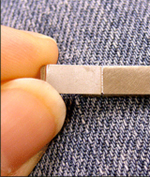8 September 2009
Laser Welding Electrical Contacts
 Laser welding has several advantages over conventional welding processes including reduced thermal distortion due to very small heat affected zones (HAZ), accurate control of heat input that allows welding close to heat-sensitive parts, and the ability to repeatedly direct the beam precisely to the weld point. In part, these laser welding applications are successful because the typical focused beam diameter of 100 microns (0.004") localizes HAZ around the weld area to fractions of an inch.
Laser welding has several advantages over conventional welding processes including reduced thermal distortion due to very small heat affected zones (HAZ), accurate control of heat input that allows welding close to heat-sensitive parts, and the ability to repeatedly direct the beam precisely to the weld point. In part, these laser welding applications are successful because the typical focused beam diameter of 100 microns (0.004") localizes HAZ around the weld area to fractions of an inch.
Unlike conventional welding techniques, laser welding is typically performed without adding filler material to the weld. This creates a homogenous junction between the two pieces without introducing foreign material in the form of filler alloys. The downside is that part fit up at the weld interface must ideally be zero to prevent undercutting of the weld joint. In actual practice, a slight gap not exceeding 10% of the thinnest piece or the actual weld depth - whichever is less - is acceptable. In addition, the conventional welding technique of creating initial spot welds at intervals along the joint helps to prevent material separation during the actual weld pass.
For this welding trial, the requirement was to fillet weld a 0.15-mm (0.006") thick steel cover to a much thicker steel substrate to create an electrical contact. The beam delivery set-up consisted of a 63.5 mm (2.5") positive meniscus lens, which provides a 100-micron (0.004") spot size with a 1.8 mm (0.07") depth of focus. Argon shield gas, at a flow rate of 3.9 cubic feet per minute (CFM), was adjusted to flow over the processing area to prevent the molten weld pool from reacting with the surrounding atmosphere. Each weld bead measures 8.25 mm (0.325") in length and was completed in approximately 1.3 seconds using 200 watts of power at a velocity of 15 inches per minute.
- Contact Information
- Name: Gary Broadhead
- Email: garyb@laserlines.co.uk

